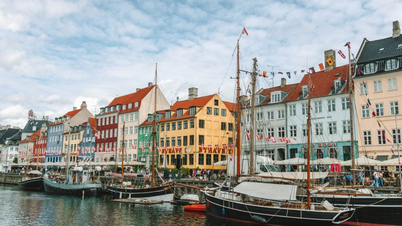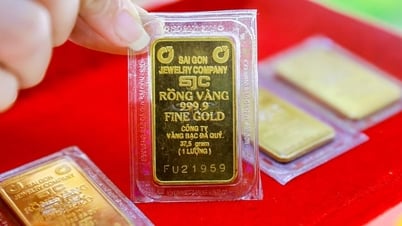We would like to introduce some representative authors to help readers gain more information and understanding about Danish literature.
Beautiful flowers in the garden
In order to help readers have more information and understanding about Danish literature, we would like to respectfully introduce some representative authors.
ABELL Kjeld (1901-1961) was a playwright. His father was an educator . He was a reformer of Danish theatre, opposing the stereotypes of the bourgeoisie and petty bourgeoisie. In his later years, he tended to introduce symbolic elements into his plays, leading to an abstract humanism (especially influenced by existentialism).
The play Melodien, der Blev Voek (1935) criticized the barren capitalist society. The play Anna Sophie Edvig (1939) expressed an anti-fascist humanism. The play Days on a Cloud (1947) questioned the responsibility of science in the atomic age.
![A Glimpse of Danish Literature [Part 7] Một thoáng văn học Đan Mạch [Kỳ 7]](https://vstatic.vietnam.vn/vietnam/resource/IMAGE/2025/1/18/53ead787eaf74980a4ae11a5a668560c) |
| Writer Hans Christian ANDERSEN. |
ANDERSEN Hans Christian (1805-1875) was a writer, the son of a poor shoemaker. He received little education, grew up self-taught, was reserved by nature, and maintained a commoner's character all his life, so when interacting with artists and aristocrats, he inevitably had complex feelings. From the age of 14, he moved to the capital, was helped by a few aristocrats, and went abroad to study several times. At the age of 17, he had published books. His first successes were his travelogues and the book The Picture Book Without Pictures (Billedoog uden Billeder, 1840). Andersen also wrote poetry, plays, and novels with a romantic flavor and petty-bourgeois humanitarianism, which are still rarely enjoyed today.
The work that made Andersen famous throughout the world for many generations was the collection of Children's Stories (Eventyr, Fortalte for Born, 1835-1841) which includes over one hundred and fifty stories. Andersen borrowed plots from myths, fairy tales, folk tales, history, and fictionalized stories based on everyday life.
The story was written for children, but adults also enjoyed reading it, because of its poetic yet realistic nature, profound philosophical meaning, upholding morality, and criticizing the bad habits of society. Andersen also told his own life as a fairy tale in The Story of My Life (Mit livs Eventyr, 1855).
The writer Hans Christian Andersen is perhaps a rare literary phenomenon in the world. Usually, countries choose massive constructions, great heroes, excellent politicians, talented generals... to be their symbols. Only Denmark chose a writer - Andersen.
Denmark calls itself the land of Andersen, of the “little mermaid”. A country with a population of just over five million, is proud to have a writer that countries with a population of hundreds of millions do not have the honor of having. Andersen often includes in his stories his unfulfilled ambitions, hopeless love, compassion for the miserable, trying to overcome his own circumstances, finding comfort in dreams and God’s grace. Typical examples are The Little Mermaid, The Little Match Girl, The Ugly Duckling…
In 2005, the world celebrated the 200th anniversary of Andersen's birth, perhaps the most translated and widely read author on a global scale. In Vietnam alone, since 1926, over one million translations have been published, all of his works transcending space and time.
ANDERSEN Nexoe Martin (1869-1954) was a Danish writer, born in Copenhagen and died in Dresden, Germany. He was the son of a stonemason. He suffered from a young age, working as a servant, a shoemaker, a teacher, and a journalist. He was mainly self-taught. In 1841, when Denmark was occupied by Germany, Andersen Nexoe was arrested and fled to Sweden and the Soviet Union. From the age of 82, he lived in the German Democratic Republic until his death.
Andersen Nexoe was a proletarian writer, representing the socialist realism trend in Northern Europe, always standing on the side of peace and progress, defending communism. In his early creative period (1893-1903), he took the working people as the central character, but had not yet escaped the bourgeois liberal ideology and decadent literary tendencies; for example, the travelogue Sunny Days (Soldage, 1903) written after visiting Italy and Spain.
Andersen Nexoe became increasingly class-conscious, especially due to his understanding of the Spanish proletariat situation (1902) and the significance of the 1905 revolution in Russia. In 1906-1910, he published the world-famous novel Pelê, the Conqueror (Pelle Erbreren). This is a work praising class-consciousness, solidarity among the exploited, reflecting the belief in the inevitable victory of social justice.
After the October Revolution in Russia, Andersen Nexoe joined the Danish Communist Party and wrote the novel Ditte, Child of Men (Ditte Menneskebarn, 1917-1921), which praised the kindness of proletarian women; an epic about the Danish proletariat.
In the four-volume series of Memoirs (Erindringer, 1932-1939), the author recounts his life.
Source



![[Photo] Prime Minister Pham Minh Chinh chairs meeting to deploy overcoming consequences of storm No. 10](https://vphoto.vietnam.vn/thumb/1200x675/vietnam/resource/IMAGE/2025/10/3/544f420dcc844463898fcbef46247d16)


![[Photo] Students of Binh Minh Primary School enjoy the full moon festival, receiving the joys of childhood](https://vphoto.vietnam.vn/thumb/1200x675/vietnam/resource/IMAGE/2025/10/3/8cf8abef22fe4471be400a818912cb85)




































































































Comment (0)